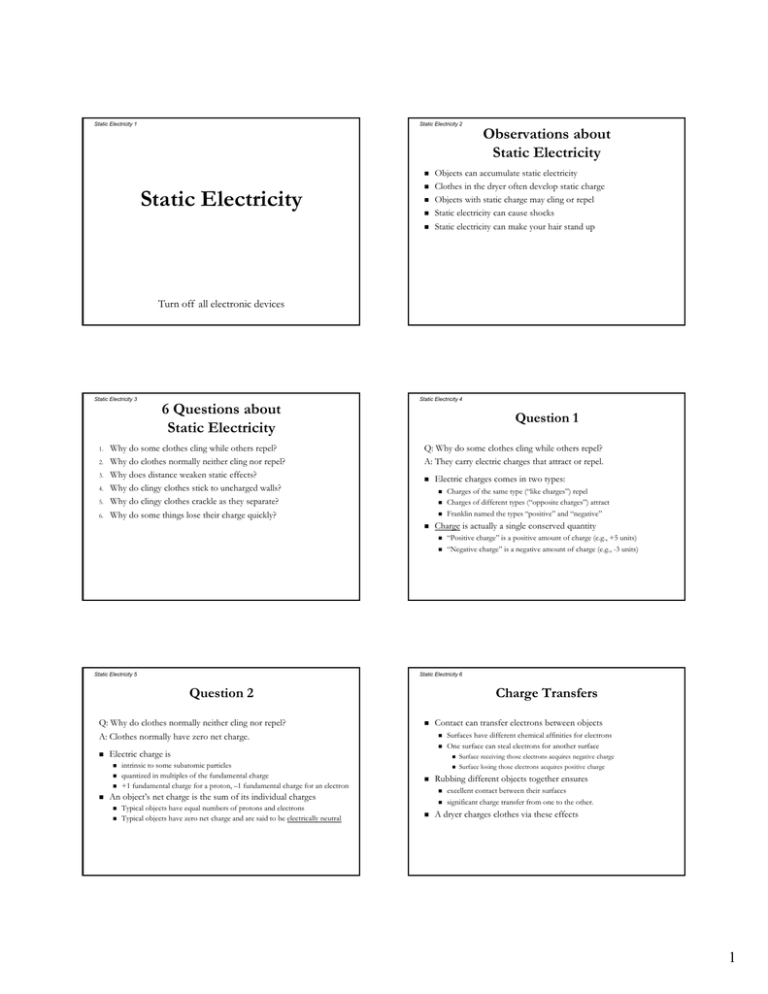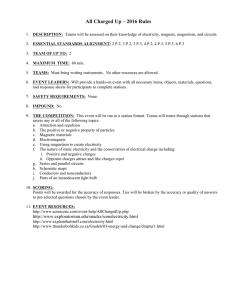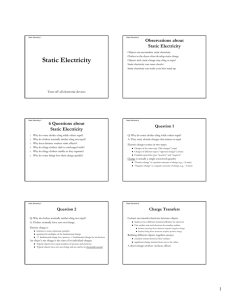Static Electricity
advertisement

Static Electricity 1 Static Electricity 2 Static Electricity Observations about Static Electricity Objects can accumulate static electricity Clothes in the dryer often develop static charge Objects with static charge may cling or repel Static electricity can cause shocks Static electricity can make your hair stand up Turn off all electronic devices Static Electricity 3 1. 2. 3. 4. 5. 6. 6 Questions about Static Electricity Why do some clothes cling while others repel? Why do clothes normally neither cling nor repel? Why does distance weaken static effects? Why do clingy clothes stick to uncharged walls? Why do clingy clothes crackle as they separate? Why do some things lose their charge quickly? Static Electricity 4 Question 1 Q: Why do some clothes cling while others repel? A: They carry electric charges that attract or repel. Electric charges comes in two types: Charge is actually a single conserved quantity Static Electricity 5 Charges of the same type (“like charges”) repel Charges of different types (“opposite charges”) attract Franklin named the types “positive” and “negative” “Positive charge” is a positive amount of charge (e.g., +5 units) “Negative charge” is a negative amount of charge (e.g., -3 units) Static Electricity 6 Question 2 Q: Why do clothes normally neither cling nor repel? A: Clothes normally have zero net charge. intrinsic to some subatomic particles quantized in multiples of the fundamental charge +1 fundamental charge for a proton, –1 fundamental charge for an electron Typical objects have equal numbers of protons and electrons Typical objects have zero net charge and are said to be electrically neutral Surfaces have different chemical affinities for electrons One surface can steal electrons for another surface Surface receiving those electrons acquires negative charge Surface losing those electrons acquires positive charge Rubbing different objects together ensures An object’s net charge is the sum of its individual charges Contact can transfer electrons between objects Electric charge is Charge Transfers excellent contact between their surfaces significant charge transfer from one to the other. A dryer charges clothes via these effects 1 Static Electricity 7 Static Electricity 8 Question 3 Q: Why does distance weaken static effects? A: Forces between charges decrease as 1/distance2. These electrostatic forces obey Coulomb’s law: Question 4 Q: Why do clingy clothes stick to uncharged walls? A: The charged clothes polarize the wall. When a negatively charged sock nears the wall, Electric charge is measured in coulombs One fundamental charge is 1.6 10-19 coulombs Static Electricity 9 Static Electricity 10 Question 5 Q: Why do clingy clothes crackle as they separate? A: Separating opposite charges boosts voltages. Charge has electrostatic potential energy Voltage measures electrostatic potential energy per unit of charge Question 6 Q: Why do some things lose their charge quickly? A: Charge can escape through electric conductors. Work raises the voltage of positive charge Work lowers the voltage of negative charge Insulators have no mobile electric charges Conductors have mobile electric charges, Voltage is measured in volts (joules/coulomb) Static Electricity 11 the wall’s positive charges shift toward the sock, the wall’s negative charges shift away from it, and the wall becomes electrically polarized. Opposite charges are nearest → attraction dominates that are usually electrons (e.g., metals) that can be ions (e.g., salt water) that will accelerate (and flow) toward lowest electrostatic potential energy Conductors allow charges to cancel or escape Summary about Static Electricity All objects contain countless charges Objects can transfer charge during contact Clothes often develop net charges during drying Oppositely charged clothes cling to one another and spark as separation raises their voltages. Conductivity tends to let objects neutralize. 2





